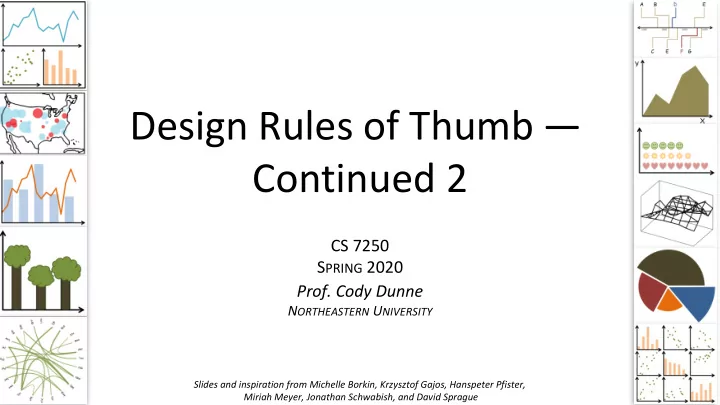

Design Rules of Thumb — Continued 2 CS 7250 S PRING 2020 Prof. Cody Dunne N ORTHEASTERN U NIVERSITY Slides and inspiration from Michelle Borkin, Krzysztof Gajos, Hanspeter Pfister, 1 Miriah Meyer, Jonathan Schwabish, and David Sprague
P REVIOUSLY , ON CS 7250… 2
JS, D3 3
I N -C LASS P ROGRAMMING — D3 L INE C HART (P ART 1) 4
N OW , ON CS 7250… 5
I N -C LASS P ROGRAMMING — D3 L INE C HART (P ART 2) 6
P REVIOUSLY , ON CS 7250… 7
“Graphical Integrity” “Clear, detailed, and thorough labeling should be used to defeat graphical distortion and ambiguity. Write out explanations of the data on the graphic itself. Label important events in the data. ” (Axes and axis labels, titles, annotations, legends, etc.) Tufte, “Visual Display of Quantitative Information” 8 (1983)
“Graphical Integrity” “The representation of numbers, as physically measured on the surface of the graphic itself, should be directly proportional to the numerical quantities measured. ” Tufte, “Visual Display of Quantitative Information” 9 (1983)
N OW , ON CS 7250… 10
D ESIGN & R ULES OF T HUMB 11
Lie Factor Lie Factor = (Size of effect in graphic) (Size of effect in data) Lie Factor = >1, overstating Lie Factor = 1, accurate :) Lie Factor = <1, understating “The representation of numbers, as physically measured on the surface of the graphic itself, should be directly proportional to the numerical quantities measured. ” Tufte, “Visual Display of Quantitative Information” 12 (1983)
Lie Factor Lie Factor = (Size of effect in graphic) Image = 5.3” - 0.6” = 7.83 = 783% (Size of effect in data) 0.6” Data = 27.5 - 18 = 0.53 = 53% 18 Lie Factor = 783% = 14.8 53% Lie Factor = >1, overstating “The representation of numbers, as physically measured on the surface of the graphic itself, should be directly proportional to the numerical quantities measured. ” Tufte, “Visual Display of Quantitative Information” 13 (1983)
Lie Factor Lie Factor = (Size of effect in graphic) Image = 5.3” - 0.6” = 7.83 = 783% (Size of effect in data) 0.6” Data = 27.5 - 18 = 0.53 = 53% 18 Lie Factor = 783% = 14.8 53% Lie Factor = >1, overstating 18 27.5 “The representation of numbers, as physically measured on the surface of the graphic itself, should be directly proportional to the numerical quantities measured. ” Tufte, “Visual Display of Quantitative Information” 14 (1983)
Data = 2 - 1 = 1 = 100% I N -C LASS A CTIVITY : Lie Factor 1 Calculate for yourself! Don’t use 3D bar Lie Factor = (Size of effect in graphic) Make sure area is charts! (Size of effect in data) proportional to data! X X!!! ✓ Image = 2 2 - 1 2 = 3 = 300% Image = 2*π1 2 - 1*π0.5 2 = 7 = 700% Image = 2 - 1 = 1 = 100% 1 2 1*π0.5 2 1 Lie Factor = 300% = 3 Lie Factor = 700% = 7 Lie Factor = 100% = 1 100% 100% 100% “The representation of numbers, as physically measured on the surface of the graphic itself, should be directly proportional to the numerical quantities measured. ” Tufte, “Visual Display of Quantitative Information” 15 (1983)
“Graphical Integrity” Data Ink = the ink used to show data Tufte: maximize the data ink ratio Data Ink Ratio = data-ink total ink in graphic Low Data Ink Ratio High Data Ink Ratio Tufte, “Visual Display of Quantitative Information” 16 (1983)
High Data Ink Ratio Reebee Garofalo, Genealogy of Pop/Rock Music 17
“Graphical Integrity” “The number of information-carrying (variable) dimensions depicted should not exceed the number of dimensions in the data. ” Tufte, “Visual Display of Quantitative Information” 18 (1983)
“No Unjustified 3D” # Dimensions in data: 3 # Dimensions in data: 3 # Dimensions in plot: 4 # Dimensions in plot: 3 “The number of information-carrying (variable) dimensions depicted should not exceed the number of dimensions in the data. ” 19
“No Unjustified 3D” Occlusion! Lie Factor! http://help.infragistics.com/Help/Doc/WinForms/2014.2/CLR4.0/h http://img.brothersoft.com/screenshots/softimage/0/3d_charts- tml/Images/Chart_Bar_Chart_03.png 171418-1269568478.jpeg “The number of information-carrying (variable) dimensions depicted should not exceed the number of dimensions in the data. ” 20
“No Unjustified 3D” Unjustified 3D! Lie factor! http://stats.stackexchange.com/questions/109076/what-is-your-favorite-statistical-graph/109080 21
“No Unjustified 3D” “The number of information-carrying (variable) dimensions depicted should not exceed the number of dimensions in the data. ” 22
“No Unjustified 3D” This is not just a design principle, it has lots of experimental and quantitative data to back it up! “The number of information-carrying (variable) dimensions depicted should not exceed the number of dimensions in the data. ” 23
Dr. David Sprague (Former Lecturer, Khoury) “The number of information-carrying (variable) dimensions depicted should not exceed the number of dimensions in the data. ” Tory, et al. (2007) 24
“Which spatial area contained the most points of a specified target value range?” “The number of information-carrying (variable) dimensions depicted should not exceed the number of dimensions in the data. ” Tory, et al. (2007) 25
“The number of information-carrying (variable) dimensions depicted should not exceed the number of dimensions in the data. ” Tory, et al. (2007) 26
“No Unjustified 3D” “The number of information-carrying (variable) dimensions depicted should not exceed the number of dimensions in the data. ” Borkin, et al. (2011) 27
A CCURACY Strong effect of dimensionality on accuracy 39% 62% How many diseased regions found? Borkin, et al. (2011)
“No Unjustified 3D” “The number of information-carrying (variable) dimensions depicted should not exceed the number of dimensions in the data. ” Pandey et al. VIS 2019
“No Unjustified 3D” “The number of information-carrying (variable) dimensions depicted should not exceed the number of dimensions in the data. ” Pandey et al. VIS 2019
“No Unjustified 3D” “The number of information-carrying (variable) dimensions depicted should not exceed the number of dimensions in the data. ” Pandey et al. VIS 2019
Recommend
More recommend